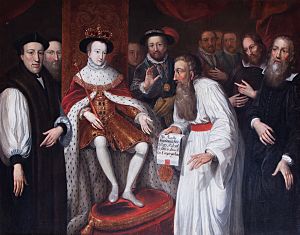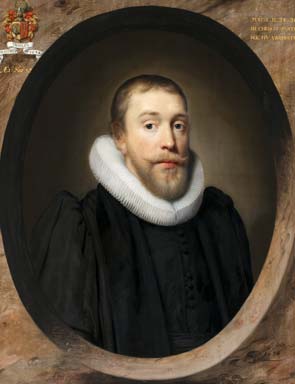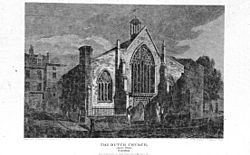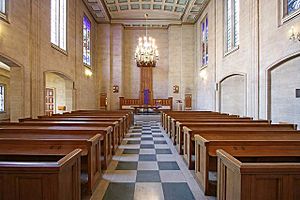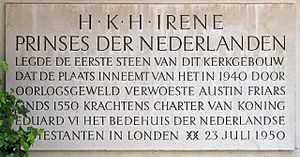Dutch Church, Austin Friars facts for kids
Quick facts for kids Dutch Church, Austin FriarsNederlandse Kerk Londen |
|
|---|---|
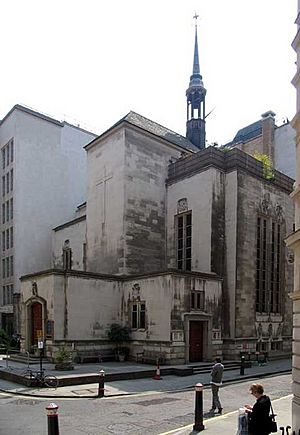
The world's oldest Dutch reformed church
|
|
| Location | 7 Austin Friars, London |
| Country | United Kingdom |
| History | |
| Founded | 24 July 1550 |
| Architecture | |
| Architect(s) | Sir Arthur Bailey |
| Style | Mid twentieth century architecture |
| Years built | 1354, rebuilt 1950–1954 |
| Demolished | 15–16 October 1940 |
The Dutch Church, Austin Friars (which is Nederlandse Kerk Londen in Dutch), is a special reformed church in the City of London. It stands in the Broad Street Ward. The church is built where an old 13th-century monastery used to be.
The first church building was given to Protestant refugees in 1550. Sadly, it was destroyed during the London Blitz, a time when London was heavily bombed in World War II. The church you see today was built between 1950 and 1954.
This church is very important because it was founded in 1550. This makes it the oldest Dutch-speaking Protestant church in the world! In The Netherlands, it's even known as the "mother church" for all Dutch reformed churches.
Contents
A Look Back: History of the Church
From Monastery to Church
The original building was a monastery called the Austin Friars, London. It was started around 1253 by Humphrey de Bohun, 2nd Earl of Hereford. The name "Austin Friars" is a shorter way of saying "Augustinian Friars," which was a type of religious group.
A famous person named Perkin Warbeck was buried here. He was executed in 1499 because he claimed to be one of the Princes in the Tower.
In 1538, the monastery was closed down as part of the Dissolution of the Monasteries. This was when King Henry VIII closed many monasteries in England. The City of London tried to buy the church part of the monastery, but the King said no.
A New Home for Refugees
In 1550, something important happened. The "Germans and other strangers" living in London were allowed to use the main part of the friary church. This part was called the nave. The rest of the church was used as a storage space.
The nave became the first official non-conformist chapel in England. This means it was a church for Protestants who didn't follow the main Church of England. Its leader was a Polish man named John a Lasco. He had started a place for Protestant refugees, mostly from the Low Countries (like modern-day Netherlands and Belgium).
On July 24, 1550, King Edward VI gave them a special permission, called a royal charter. This allowed them to create a "Stranger Church." It was named the "Temple of the Lord Jesus." It had four pastors: two for Dutch speakers and two for French-speaking Walloons. The French-speaking group later moved to their own church in Threadneedle Street.
Dutch Community in London
By 1570, the Dutch community was the largest group of people from other countries living in London. There were about 5,000 Dutch people out of London's total population of 100,000. Many of these Dutch people were Protestants who had to leave their homes because they were being treated badly for their religion.
Others were skilled workers, like brewers, weavers, artists, and printers. They came to England looking for better jobs. For example, Martin Droeshout, an engraver famous for his portrait of William Shakespeare, was one of these Dutch immigrants.
Later, when William of Orange became King of England, more Dutch people came to London. This group included noblemen, bankers, and artists.
The Church in the 20th Century
Destroyed and Rebuilt
On the night of October 15–16, 1940, the old medieval church building was completely destroyed. This happened during the London Blitz, when German bombs hit the city. This was just ten years before the Dutch Church's 400th birthday.
Luckily, the church's valuable collection of rare books, including old Dutch Bibles and atlases, had been moved out of London for safety the day before the bombing. The church's old handwritten documents and its original royal charter are now kept at the London Metropolitan Archives. The church is also working to put its library collection online.
A New Beginning
The first stone for the new church was laid on July 23, 1950. A 10-year-old girl, Princess Irene of the Netherlands, helped with this special event. The new church was designed by an architect named Arthur Bailey and was finished in 1954.
The new building is made of concrete and covered with Portland stone. It has beautiful stained glass windows from the 1950s, made by artists like Max Nauta and Hugh Ray Easton. The church also has detailed records of its history and is a popular place for visitors.
In 1998, the church was named a Grade-II listed building. This means it's an important historical building that needs to be protected. In 2000, the church celebrated its 450th anniversary! A book about its history, called De Kerk in de City, was published by Prof. Keetie E Sluyterman from the University of Utrecht.
The Church Today: 21st Century
The Dutch Church is still very active today. It holds weekly church services in Dutch. It also offers confirmation classes and meetings for different groups. The church helps the Dutch community in London, including looking after older people.
The church is also home to two other charities: The Netherlands Benevolent Society (NBS) and The Dutch Centre. In 2015, Princess Beatrix of the Netherlands was a special guest at the church. She was there to celebrate 150 years since the NBS was founded. On the same day, The Dutch Centre was officially opened.
Images for kids


